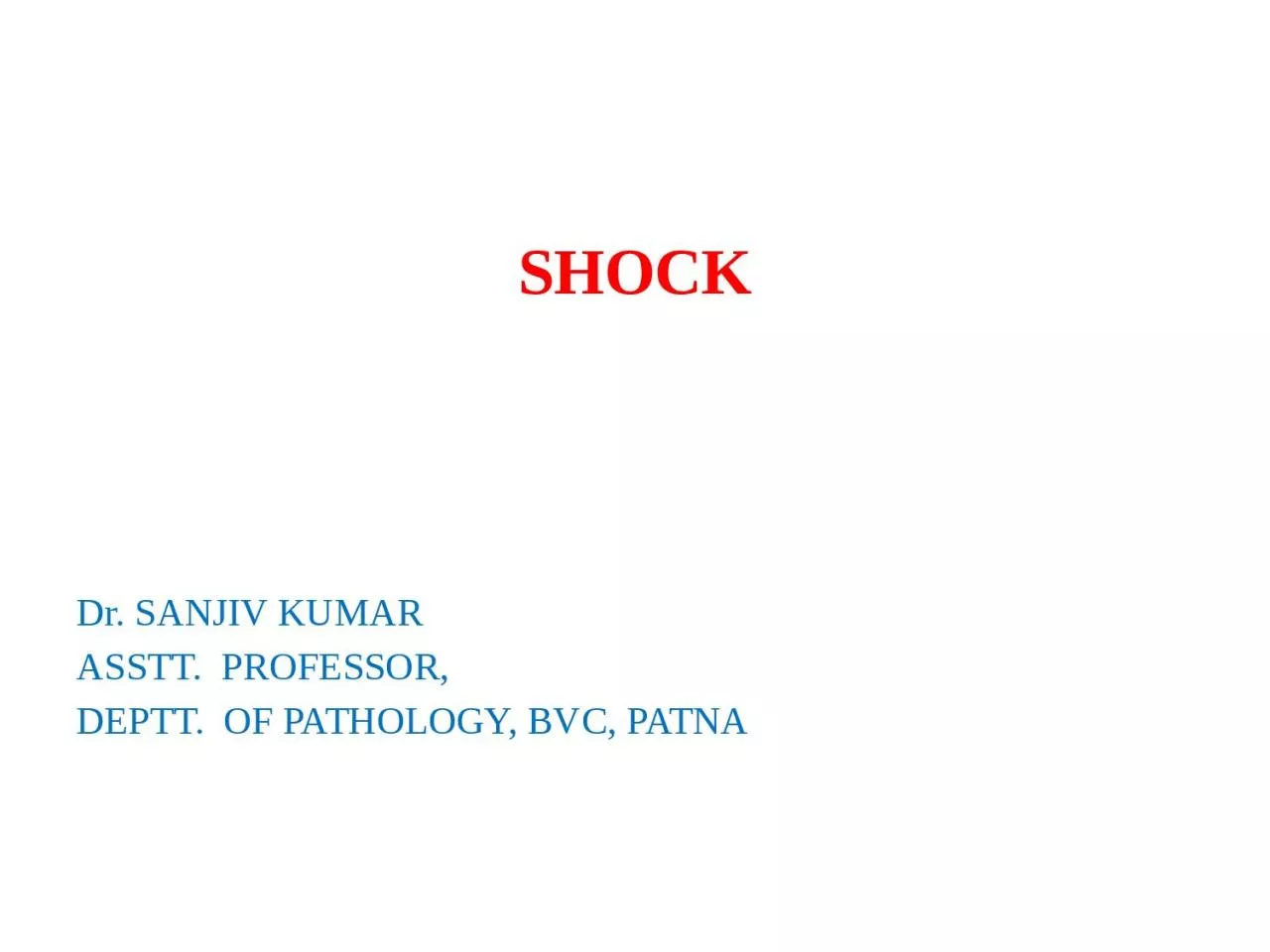

DEPTT OF PATHOLOGY BVC PATNA Definition Failure of the circulatory system to adequately perfuse vital organs An emergency condition Types Cardiogenic shock Hypovolemic shock ID: 928156
Download Presentation The PPT/PDF document "SHOCK Dr. SANJIV KUMAR ASSTT. PROFESSOR..." is the property of its rightful owner. Permission is granted to download and print the materials on this web site for personal, non-commercial use only, and to display it on your personal computer provided you do not modify the materials and that you retain all copyright notices contained in the materials. By downloading content from our website, you accept the terms of this agreement.
Slide1
SHOCK
Dr. SANJIV KUMAR
ASSTT. PROFESSOR,
DEPTT. OF PATHOLOGY, BVC, PATNA
Slide2Definition
Failure of the circulatory system to adequately perfusevital organs.An emergency condition.
Slide3Types
Cardiogenic shockHypovolemic shock
Septic/
Endotoxic
shock
Neurogenic shock
Anaphylactic shock
Slide4Results from cardiac pump failure
Cardiac output= heart rate x stroke volumeCause:Myocarditis-Septicaemia or viral infection
Myocardial degeneration
-Vita E/Se def, infarcts
Cardiac
temponade-HaemopericardiumElectrolyte imbalance-Hyperkalemia in uremic animals
CARDIOGENIC SHOCK
Slide5Mechanism
Inadequate cardiac output Hypotension
I
mpaired
tissue
perfusion Cellular hypoxia
Slide6Sudden severe loss of blood volume
Acute haemorrhage->1/4th to 1/3rd Loss of fluid: vomiting,
diarrhoea
etc.
Increased vascular permeability
Loss of intravascular fluid & proteinsHypovolemic Shock
Slide7Hypovolemic
ShockCardiogenic shock
Internal fluid loss
External fluid loss
Increased vascular permeability
EndotoxaemiaBurns
Haemorrhage
Diarrhoea
Decreased blood volume
Decreased venous return
Myocarditis
Cardiac
temponade
Decreased cardiac output
Decreased tissue perfusion
Anoxic cell injury
Endothelial damage
Heart failure
Anaerobic
glycolysis
in muscles
Metabolic acidosis
Renal failure
Slide8Results from bacterial infection in which large quantities of
endotoxins are released into circulation.Endotoxins are complex components of cell wall of gram -ve bacteria (LPS)Endotoxins bind to serum proteins
Resulting complex bind to Macrophage/monocyte
TNF alpha, IL-1 secreted into circulation
Marked capillary dilation
Severe pooling of venocapillary blood Decreased cardiac venous return Cardiovascular collapseSEPTIC/ENDOTOXIC SHOCK
Slide9Systemic manifestation of an acute allergic response
Exposure to allergens Activation of mast cells or other effector cells Release of histamine and other chemical mediators
Marked
venocapillary
dilation
Increased vascular permeability Loss of intravascular fluid Decreased cardiac venous returnCardiovascular collapse
Anaphylactic shock
Slide10Severe trauma,
anaesthetic accident, spinal cord injury.There is disruption of vasomotor control, loss of vascular tone, vasodilation and peripheral pooling of blood.
NEUROGENIC SHOCK
Slide11Decreased tissue perfusion causes anoxic injury
Anoxic injury to endothelial cells Insufficient renal & muscular perfusionIncreased vascular permeability metabolic acidosis Loss of intravascular fluid Suppress cardiac outputInsufficient myocardial perfusion Anoxic injury to myocytes Decreased cardiac output
CLINICAL CONSEQUENCES OF SHOCK
Slide12Increase in heart rate and contractibility
Increased blood pressure through vasoconstrictionConserve body waterBODY RESPONSE TO SHOCK